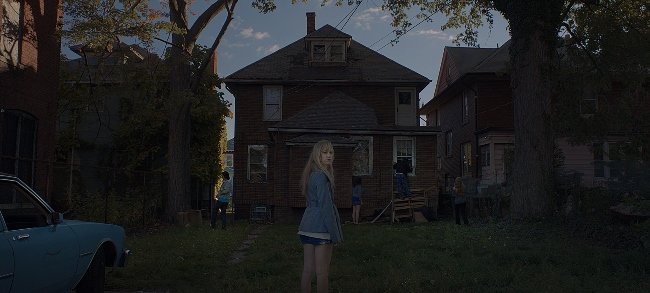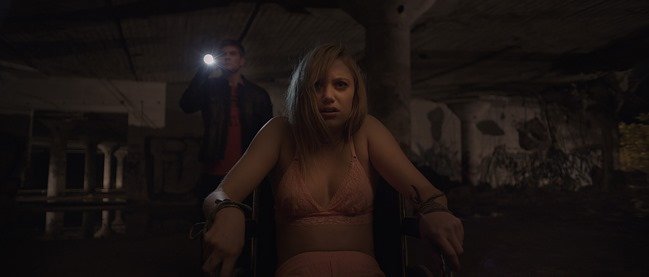
Sure, a lot of beginning moviemakers cut their teeth on horror. It’s become a calling card for directors hoping to demonstrate their technical or stylistic prowess.
Unfortunately, very few attempt to challenge the B-movie expectations that accompany the genre, relying instead on homage to stake out their cinematic influences.
Writer-director David Robert Mitchell took a slightly different route. His first feature, 2010’s The Myth of the American Sleepover, was an impressionistic ode to the awkwardness of suburban adolescence. Set over the course of a single summer evening, it was clearly inspired by the likes of American Graffiti and Dazed and Confused. But unlike the raucous energy of those films, Mitchell’s low budget indie had a dreamy, laid-back style that won it festival awards and critical praise.
Then, with his sophomore effort, It Follows, Mitchell jumped enthusiastically onto the low-budget horror bandwagon. Maintaining the same patient, atmospheric approach of his debut, he reshapes tried-and-true scare conventions—teens in peril, a relentless malevolent force, jarring soundtrack—into an unexpectedly unique creepfest that’s cleverly geared to its modest production budget.
In It Follows, a group of suburban Detroit teens are stalked by a mysterious and lethal force that is both acquired and waylaid by sexual intercourse. Like a twisted game of Tag, the only way to avoid death is to pass the supernatural STD onto someone else. Even then, the threat is merely delayed, as the slow-moving creature (which can look like anyone) murders the afflicted then works its way back up the chain.
We caught up with Mitchell at the Sundance Film Festival, where he was struggling with a severe cold but enjoying the buzz It Follows was generating with both critics and audiences.
Jeff Meyers, MovieMaker Magazine (MM): One of the things that struck me about It Follows is the way you handle sex. You’ve got the obvious metaphor that sex is a pivot point into adulthood where you have to consider mortality. But I also thought it was interesting that the act of intercourse—which is usually punished in horror films—is both a curse and salvation for the characters. It’s what gets you into trouble and how you can get out of it.
David Robert Mitchell (DRM): It’s never my intention to present sex as something that someone should not be doing or something that should be looked down on. When a character has sex they might open themselves up to this danger, but at the same time it’s the thing that can, at least temporarily, liberate and free them. One idea is that, basically, we’re all dealing with our mortality on some level. Sex and love are some of the ways that we’re able to push it away or push it a little bit into the distance. It’s how we cope. It’s finding some peace through our relationships with other people. Sex is an important part of that. To me, that’s what it comes down to—you’re not going to get away from it, but you can still find some happiness in between. But that’s just one read on the film. I’ve heard all kinds of theories and I think they’re all interesting.
MM: Are there moments where you think, “Wow, that interpretation wasn’t even close to what I was thinking?”
DRM: There have been some really cool ones, and then there are some—not too many, but I’ve noticed there are some—who are reading it that we’re somehow condemning the characters in some way. I don’t see it that way at all. To me, that’s a misinterpretation of the film. But you know what? People can read it however they want to read it.
MM: In both your films there’s a distinct lack of adult characters. It reminded me a bit of Charlie Brown.
DRM: Yeah, there’s a bit of a Peanuts kind of thing going on. I did that for a different reason [in my first film]. That was a younger cast and it was more about creating this magical space, like outside of the adult world. With this [It Follows], it’s about isolating the characters so that they’re alone and that it’s a little bit more like a nightmare.
MM: You took a very interesting approach to It Follows with your detached, widescreen compositions. And I imagine that it took some planning to get the tension and pace just right given that the horror comes from someone walking toward the characters very slowly.
DRM: It’s a risky thing. You know, it’s a hard thing to explain, because when you’re making a movie like this, I felt dread and anxiety when I wrote the script. But from that point on, it’s really hard to connect with that, and when you’re shooting, it’s all about just trying to get the film done. We have to move pretty quickly.
MM: So how do you achieve the mood and atmosphere you need?
DRM: In doing each individual shot in each of the scenes, it’s difficult to actually feel that level of anxiety. You can’t really maintain that within yourself, so it’s about trusting the feeling you had when you created that sequence, and then trying to get the elements of that within the shot and then trusting that all those pieces together will build. But it’s really about having that plan. I mean, that’s sort of the best way I can explain it. I know it’s not very clear, but…
MM: No, it’s good. But let’s talk about your shooting approach.
DRM: It’s a fairly cold camera and most of the movie is shot on an 18mm lens. We mostly tried to leave a lot of space in the frame—in the distance, on the edges—so that it’s pretty objective. The idea was that [the audience] can see into the distance, see along the edges, so once we set up what’s happening, they would start to scan the frame because we’re not necessarily spoon-feeding where that danger is coming from. Then the danger can come from anywhere and it can be anyone. Once you establish that, anyone and anything in the frame can start to frighten people.
MM: Talk to me a little bit about your relationship with your DP. What’s your process of collaboration?
DRM: The DP is Mike Gioulakis, a really talented guy. I knew him back from film school in Florida. Mike and I started planning the look of the film well before pre-production. I’d gone through and story-boarded the movie and we would get together every week for a long period of time until we really understood how we wanted to approach the film. It was very specific. We were working on it months before we ever went to Michigan and started shooting.
MM: When you’re working with your DP or, say, your composer, do you invite collaboration or even push back on your ideas?
DRM: Yeah. I mean, as long as we ultimately reach a point where everybody’s cool with things. Or at the same time, if we disagree, that they’re cool enough to trust that I know what I’m doing, just because I live with it longer than anybody. My editor is a very good friend of mine and we’ve known each other since film school—he cut my first film and this one. He’ll tell me when he doesn’t think something’s right, or not working. Sometimes I’ll be offended for a second and sometimes I’ll disagree, and I’ll tell him why, but we’ll figure it out. I think I had a very specific idea for what I wanted the film to be, and I brought on people that got that.
MM: You mentioned that you met your editor in film school. Tell me a little about the film school experience and what it did or didn’t do for you.
DRM: I had a really good experience at film school [in Florida State University]. There’s always negatives. The negative is the money it costs. Anyone going should really think about that, because it just costs a lot of money to go. Sometimes I wonder, dealing with just that aspect of it, if there’s a way to have all those experiences without spending all that money, but I don’t know. For me, it was the right thing to do. We made short films and we had to do all the different jobs and, yeah, I probably gained some confidence. I felt good going in, but I felt even better getting out of there. The big positive was that I met a lot of great friends and collaborators. Mike Gioulakis, my cinematographer on It Follows—I met him in Tallahassee, Florida. Julio Perez, my editor—I met him in Tallahassee. The cinematographer on Myth, James Laxton came from Florida. So I don’t know if I would’ve been able to do what I’ve done without those people.
Honestly, the biggest upside is having friendships with people who are insanely dedicated to filmmaking. Because a lot of people like film, but you have to be batshit-crazy-in-love with the idea of making movies and sacrificing for it, to do it. I met a bunch of those people there. MM
It Follows opens in theaters March 13, 2015, courtesy of RADiUS-TWC.
Share:



